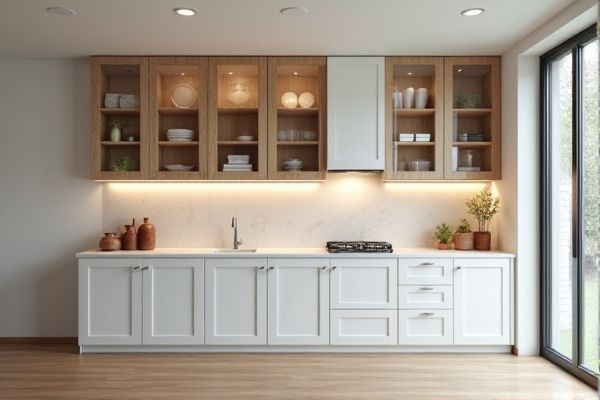
Overhead cabinets maximize vertical storage space and keep frequently used items within easy reach, while base cabinets offer sturdy support for countertops and larger storage capacity for heavy kitchenware. Explore the rest of this article to discover which cabinet type best suits your kitchen's functionality and design.
Table of Comparison
| Feature | Overhead Cabinets | Base Cabinets |
|---|---|---|
| Location | Mounted on walls above counters | Located on the floor below countertops |
| Primary Use | Storage for dishes, glassware, and lighter items | Storage for pots, pans, appliances, and heavy items |
| Height | Typically 12-42 inches tall | Standard height around 34.5 inches |
| Depth | 12-24 inches deep | 24 inches deep or more |
| Installation | Wall-mounted with brackets or screws | Placed on floor and secured to walls |
| Accessibility | Requires reaching or step stool for some users | Easy access at waist or knee level |
| Weight Capacity | Designed for lighter items | Supports heavier, bulkier kitchen items |
| Common Materials | Wood, MDF, laminate, metal | Wood, MDF, laminate, metal with reinforced bases |
| Cost | Generally less expensive per unit volume | Higher cost due to size and construction requirements |
Overview of Overhead Cabinets vs Base Cabinets
Overhead cabinets are wall-mounted storage units designed to maximize vertical space, typically used for storing lighter items like dishes and glassware. Base cabinets rest on the floor and provide sturdy support for countertops, offering ample storage for heavier kitchen tools and cookware. Your choice between overhead and base cabinets depends on available space, storage needs, and kitchen workflow efficiency.
Key Differences in Design and Structure
Overhead cabinets are mounted on walls above countertops, providing elevated storage space that keeps frequently used items within easy reach while maximizing vertical kitchen space. Base cabinets rest on the floor and support countertops, offering larger storage capacity for heavier kitchen appliances and pots, with design elements like drawers and shelves tailored for accessibility. The structural differences influence kitchen layout efficiency, with overhead cabinets designed for lighter loads and visual openness, whereas base cabinets are built for durability and substantial storage requirements.
Space Utilization and Storage Capacity
Overhead cabinets maximize vertical space, ideal for storing lightweight items and frequently used kitchenware, thus freeing up countertop area. Base cabinets offer greater storage capacity and sturdier support, suitable for heavier appliances, large pots, and pantry goods. Together, these cabinet types optimize kitchen organization by balancing accessible storage with efficient space utilization.
Installation and Placement Considerations
Overhead cabinets require secure wall studs for proper installation, ensuring they can support heavy contents without risk of falling, while base cabinets are anchored to the floor, providing sturdy support for countertops and appliances. Placement of overhead cabinets should consider ease of access and avoid obstructing windows or lighting, whereas base cabinets must allow for sufficient legroom and accommodate plumbing or electrical outlets. Your kitchen layout and functionality needs will determine the ideal combination of overhead and base cabinets for optimal use and aesthetics.
Accessibility and Ergonomics
Overhead cabinets offer easy accessibility for frequently used items by keeping them at eye level, reducing the need to bend or reach downward, which supports ergonomic efficiency in your kitchen. Base cabinets, while providing substantial storage space, require more bending and reaching, potentially causing strain during prolonged use. Selecting cabinets based on your workflow needs enhances comfort and minimizes physical effort in daily tasks.
Aesthetic Impact on Interior Design
Overhead cabinets create a sense of openness and elevate the visual height of a room, enhancing light flow and maximizing wall space, while base cabinets provide a sturdy foundation that anchors the design with functional storage and countertop workspace. The choice between overhead and base cabinets significantly influences the balance and proportion within interior design, contributing to the room's overall harmony and style. Incorporating both types strategically allows for a dynamic aesthetic, blending vertical and horizontal elements that complement modern, traditional, or transitional kitchens and living spaces.
Material and Construction Options
Overhead cabinets typically feature lightweight materials such as plywood or MDF with laminated finishes for durability and ease of installation, while base cabinets often use thicker plywood or solid wood for increased strength to support countertops and stored items. Both cabinet types offer construction options including framed or frameless designs, with frameless providing more accessible storage space and a modern aesthetic. Material choices impact durability and weight capacity, making solid wood or high-grade plywood preferable for base cabinets, whereas overhead cabinets prioritize lighter materials to ensure safe wall mounting.
Maintenance and Cleaning Comparison
Overhead cabinets typically require less frequent cleaning due to their elevated position, reducing exposure to spills and grease compared to base cabinets. Base cabinets often accumulate dirt and grime from floor-level splashes, necessitating more regular wiping and maintenance. Both cabinet types benefit from using gentle, non-abrasive cleaners to preserve finishes and ensure longevity.
Cost Factors and Budget Planning
Overhead cabinets typically cost less per linear foot than base cabinets due to simpler construction and smaller dimensions, impacting overall kitchen remodeling budgets. Base cabinets require more materials and labor, including countertop installation, which increases total expenses significantly. Budget planning should allocate higher funds for base cabinets to cover these additional costs while using overhead cabinets strategically to balance functionality and cost efficiency.
Choosing the Right Cabinets for Your Needs
Overhead cabinets maximize vertical storage space, ideal for frequently accessed items, while base cabinets provide sturdy support and generous countertop area for food preparation. Your choice depends on kitchen layout, storage requirements, and ease of accessibility, with overhead cabinets enhancing visibility and base cabinets offering stability. Prioritize functionality and convenience to create a balanced kitchen environment tailored to your daily cooking habits and organizational preferences.
 homyna.com
homyna.com